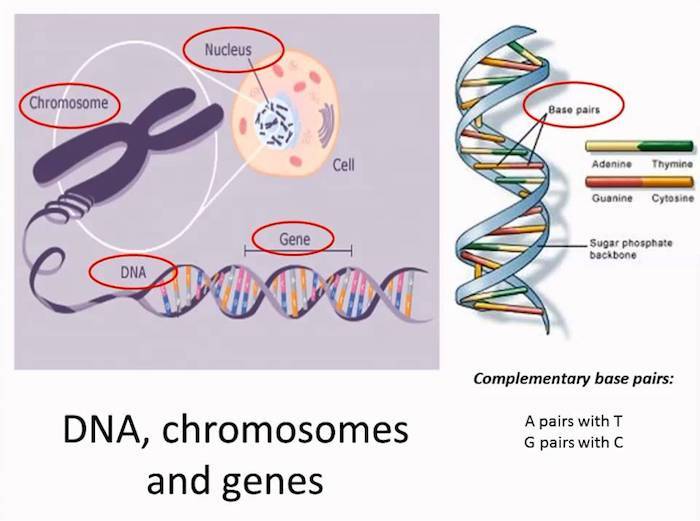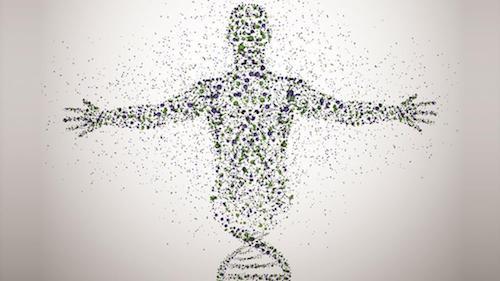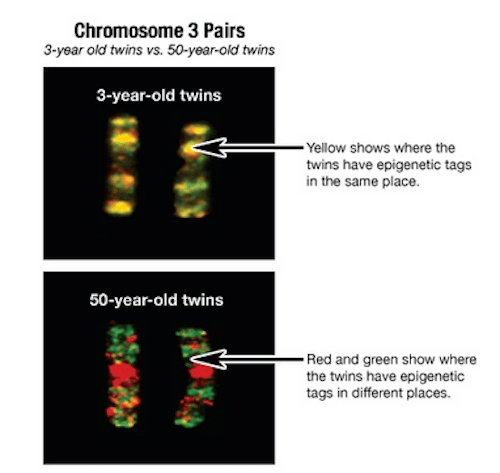Why Do Twins Grow Apart? Epigenetics Tells the Tale.

You may not have an identical twin, but the reasons they grow apart are the same as why your DNA does not rule over your body and mind alone. DNA gets altered by your epigenome, and how that happens is well within your control.
Credit: Oprah Winfrey and Harpo Productions
Twins grow apart, even if identical, because their respective epigenome changes. When born, identical twins have the same DNA, which is their genome. But as they get older and make different lifestyle choices and live in different environments, how that DNA is expressed gets altered by their differently evolving epigenome.
Read on to learn what that is, how that happens, and why it’s relevant and important to you.
Your Genome Is Steel
Identical twins have the same genome. The genome is all genetic information of an organism. It consists of nucleotide sequences of DNA, which are packed into cells’ nuclei.
Here’s a brief biology lesson:
Cells are fundamental working units of every human being. All the instructions required to direct their activities are contained within the chemical deoxyribonucleic acid, also known as DNA.
DNA from humans is made up of approximately 3 billion nucleotide bases. There are four fundamental types of bases that comprise DNA – adenine, cytosine, guanine, and thymine, commonly abbreviated as A, C, G, and T, respectively. The sequence, or the order, of the bases is what determines our life instructions.
Genes are specific sequences of bases that provide instructions on how to make important proteins – complex molecules that trigger various biological actions to carry out life functions. There are about 20,000 genes within the 3 billion nucleotide bases.
Chromosomes are long DNA molecules with part or all of the genetic material of an organism. Human chromosomes include packaging proteins called histones which, aided by chaperone proteins, bind to and condense the DNA molecule to maintain its integrity.
A picture may help visualize all this:
Incredible as it sounds, each of us has enough DNA to reach from here to the sun and back more than 300 times. You might wonder how it’s possible that all of that DNA can be packaged so tightly into chromosomes and squeezed into a tiny nucleus?
Cold Spring Harbor Laboratory’s DNA Learning Center has a short video illustration that demonstrates how DNA is packaged:
In the video animation you saw the remarkable way our DNA is tightly packed up so that it fits into the microscopic nucleus of every cell. The process starts when DNA is wrapped around special protein molecules called histones. The combined loop of DNA and protein is called a nucleosome.
Next the nucleosomes are packaged into a thread, which is sometimes described as “beads on a string”. The end result is a fiber known as chromatin. The chromatin fiber is coiled into a structure called a “solenoid”.
This fiber is then looped and coiled yet again, leading finally to the familiar shapes known as chromosomes, which can be seen in the nucleus of dividing cells shown in the animation.
Chromosomes are not always present. They form around the time cells divide when the two copies of the cell’s DNA need to be separated. At other times, as we can see now after the cell has divided, our DNA is less highly organized. It’s still wrapped up around the histones, but not coiled into chromosomes.
This is all not some abstract piece of genetics; rather, the story about how DNA is packaged is also the story about what has to happen in order for those genes to be “expressed” — turned “on’ or “off” in order to optimize your health potential, as you’ll see in the next section about the plasticity of the epigenome.
In the case of identical twins, their DNA is the same, and like with everyone’s DNA, it doesn’t change. The DNA instructions for various functional proteins to be produced inside a cell needed for an organism to develop, survive and reproduce is fixed, but whether or not they are expressed is not. Thus, for identical twins, those DNA instructions are the same, but can be read differently, because each twin can have a different epigenome. This is why twins start out life identical, but grow apart.
How this happens is the story of your epigenome.
Your Epigenome Is Plastic
Whereas your genome is all of your genetic information, your epigenome is a record of the chemical changes to the DNA and histone proteins.
Just as the genome has its own area of study called genetics, the epigenome is studied through the lens of epigenetics. In a nutshell, epigenetics is the study of:
“… heritable changes in gene expression or cellular phenotype caused by mechanisms other than changes in the underlying DNA sequence.”
Epigenetics” means “above genetics”, as if some mystical unseen hand intrudes to influence your genetics.
Turns out — as you’ll soon see — that the mystical hand is your own.
Here are a few important points to know about epigenetics:
Epigenetics Controls Genes. This happens via nature and nurture. Nature is when epigenetics determines a cell’s specialization (e.g., skin cell, blood cell, hair cell, liver cells, etc.) as a fetus develops into a baby through gene expression (active) or silencing (dormant). At this point, our proverbial twins are the same. Nurture is when lifestyle and environmental inputs cause genes to be turned “off” or turned “on” in terms of whether or not they’re expressed.
Epigenetics Is Everywhere. What turns genes on and off over time? What you eat, where you live, who you interact with, when you sleep, how you exercise, even aging – all of these can eventually cause chemical modifications that govern gene expression. In certain diseases such as cancer or Alzheimer’s, various genes will be switched into the opposite state, away from the normal/healthy state.
Epigenetics Makes Us Unique. Even though we are all human, why do some of us have blonde hair or darker skin? Why do some of us hate the taste of mushrooms or eggplants? Why are some of us more sociable than others? The different combinations of genes that are turned on or off is what makes each one of us unique — true even for identical twins. Furthermore, there have been indications that some epigenetic changes can even be inherited, although this is still being debated.
Epigenetics Is Plastic. With more than 20,000 genes, what will be the result of the different combinations of genes being turned on or off? The possible arrangements are enormous! The plasticity — meaning the changeability — of gene expression via epigenetics holds the promise of managing gene expression such that we might cure cancer, slow aging, stop obesity, and much more.
Let’s employ an analogy to better help understand the difference between genetics and epigenetics: computer hardware (the machine, aka) is the genome, and software (instructions to the machine) is the epigenome.
In our analogy, the computer hardware does the work, but the software tells it what to do. Likewise for us, the genome does the work, but the epigenome tells it what to do.
The hardware DNA will stay the same throughout your life, but the epigenetic “tags” do change, and they decide what genes get expressed.
Epigenetic tags regulate gene expression by acting as gatekeepers, blocking or allowing access to a gene’s ‘on’ switch. These chemical tags (such as methyl or acetyl groups) are added directly to DNA or onto histones, the large spool-like proteins around which DNA is tightly wound.
In this next section, you’ll see the epigenome in action as applied to twins. Epigenetic twin studies demonstrate how the epigenome can change gene expression, and thereby change how people with identical genetics — twins — experience life.
How Twins Grow Apart: The Epigenome In Action
The genetics department of the University of Utah has a really informative page on it’s website about the epigenetic insights derived by studying identical twins. Twin studies have done much to identify a number of behavioral traits and diseases that are likely to have a genetic component, and others that are more strongly influenced by the environment.
Check out these pictures that compare three year-old twins to 50 year-old twins to see the stark contrast in how many epigenetic tags show up in different places along their respective chromosomes as they aged:
The picture above shows chromosome pairs in each set of twins that are digitally superimposed. One twin's epigenetic tags are dyed red and the other twin's tags are dyed green. When red and green overlap, that region shows up as yellow. The 50-year old twins have more epigenetic tags in different places than do 3-year-old twins.
They share the same genes, but as identical twins grow up and move apart, twins grow apart, because their environments become dissimilar, as do their lifestyles.
In the beginning of their lives, identical twins look like this:
As twins grow apart, many physiological differences occur, which in the extreme can change how they look and the underlying biology like this:
This makes identical twins an excellent model by which to measure how genes and the environment contribute to certain traits, especially complex behaviors and diseases.
For example, when just one twin gets a disease, researchers can look for different elements in their respective environments and behaviors. Such observations are collected from large numbers of twin studies and help pinpoint the molecular mechanism of a disease and determine the extent of environmental influence, potentially leading to the prevention and treatment of complex diseases.
Again, it’s the cumulative effects of nature plus nurture that dictates your health and healthspan.
And to make that clear as a bell, it’s time for another video, this one that does a great job of showing you how epigenetics works using the example of why identical twins grow apart.
It’s unlikely that you’re a twin, but nonetheless, you have a vested interest in understanding how the epigenome works, because it’s a gateway for you to influence your health and even how you age.
Here’s a summary of the epigenetics video:
-They originate from the same DNA, but identical twins grow apart due to epigenetics. Epigenetics is the study of how DNA interacts with the multitude of smaller molecules found within cells, which can activate and deactivate genes.
-Genes in DNA are expressed when they’re read and transcribed into RNA, which is translated into proteins by structures called ribosomes. Proteins largely determine a cell’s characteristics and function.
-Epigenetic changes can boost or interfere with the transcription of specific genes by epigenetic/chemical tags such as methyl or acetyl groups that are added directly to DNA or onto histones, the large spool-like proteins around which DNA is tightly wound.
-The set of all of the chemical tags that are attached to the genome of a given cell is called the epigenome.
-A methyl group inhibits gene expression by derailing the cellular transcription machinery or causing the DNA to coil more tightly, making it inaccessible. The gene is still there, but it’s silent. Boosting transcription is the opposite. Some chemical tags will unwind the DNA, making it easier to transcribe,which ramps up production of the associated protein.
-Each of the approximately 200 cell types in your body has essentially the same genome, but its own distinct epigenome. The epigenome also mediates a lifelong dialogue between genes and the environment.
-The chemical tags that turn genes on and off can be influenced by factors including diet, chemical exposure, and medication.
-Epigenetic changes can eventually lead to disease, if, for example, they turn off a gene that makes a tumor-suppressing protein. Environmentally-induced epigenetic changes are part of the reason why genetically identical twins can grow up to have very different lives. As twins get older, their epigenomes diverge, affecting the way they age and their susceptibility to disease.
-Epigenetic changes are sticky, but they’re not necessarily permanent. A balanced lifestyle that includes a healthy diet, exercise, and avoiding exposure to contaminants may in the long run create a healthy epigenome.
There’s a saying in the field of genetics that goes like this:
Genetics loads the gun, but behavior pulls the trigger.
And now you have a pretty good idea about how this happens. What we do, eat, smoke, our stress level — they all affect what genes get triggered.
What You Can Do Influence Your Epigenome
I hope you watched the two videos. They will help you understand how the important differences between your genome and epigenome underscore that your lifestyle and environmental choices impact your health and how you age.
Remember the last statement of the second video:
“Once we understand how our epigenome influences us, we might be able to influence it, too”.
That conclusion could be stronger, because in fact it’s not that we “might” be able to influence our epigenome toward better health, but that we “can” do.
I’ve written much about what you can do to age more healthily, and thereby lengthen your healthspan. Choose what you want to tackle from this short list of my blog posts:
- Your Anti-aging Lifestyle Must Address These Concerns
- How To Improve Your Healthspan, Say 5 Scientists
- 3 Ways to Increase DNA Methylation and Get Biologically Younger
- How 3 People Reduced Their Body Age By 29 Years In 3 Months
- How Superagers Age Superbly and Why You Can Too!
- 7 Anti-aging Interventions Backed By Science, Part 1: CR and Fasting
- Here’s How To Increase Healthspan With Exercise and Diet, Says Science.
- Why You Must Exercise for Longevity and How To Do It
- How You Can Reduce Your Biological Age By One Year Per Week
Your Takeaway About Why Twins Grow Apart
Remember these three things:
- Until medical technology advances, your DNA is fixed, pretty much as unbendable as steel, but…
- How your genes are expressed (turned “on” and “off”) is plastic — molded by your lifestyle choices and environmental factors, which means…
- Your health and how you age are within the span of your control.
Last Updated on October 23, 2021 by Joe Garma







